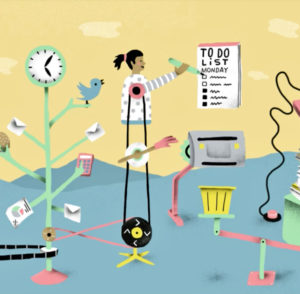 My client Phyllis Korkki (http://PhyllisKorkki.com), author of THE BIG THING: How to Complete Your Creative Project Even if You’re a Lazy, Self-Doubting Procrastinator Like Me, recently put a lot of her research and knowledge into this productivity guide for the New York Times.
My client Phyllis Korkki (http://PhyllisKorkki.com), author of THE BIG THING: How to Complete Your Creative Project Even if You’re a Lazy, Self-Doubting Procrastinator Like Me, recently put a lot of her research and knowledge into this productivity guide for the New York Times.
» Here is the link to the digital guide (which I recommend since it has a lot of other links).
» And here’s the link to the pdf of it.
Here’s one small sample from the guide:
Common Productivity Myths
Here’s the truth behind common misconceptions about working smart.
Myth: People who are good multitaskers get more done.
Fact: Multitasking is an illusion. Research shows that people get more done if they concentrate on one task at a time. Switching frequently between tasks – or believing that you are actually doing more than one thing at once – will actually slow you down.
Myth: It’s important to have zero emails in your inbox by the end of the day.
Fact: The goal of “inbox zero” works for some people but not for others. The key to managing email is to designate specific times of the day for reading and responding to it, to differentiate between emails that can be handled quickly and those that require more time, and to learn how to use all of your email software’s features (folders, filters and archives) in ways that work best for you.
Myth: It’s best to stand while you work.
Fact: It’s better to change your position throughout the day, in a regular cycle of sitting, standing and moving around. Among other things, this variety helps bring more blood to your brain, improving your cognition and therefore your productivity.
Myth: The more hours you work, the more you get done.
Fact: It is important to take breaks throughout the workday. Even a five-minute walk around the office can boost your mood with no impact on your ability to focus. Getting enough rest and sleep can serve you better than working longer hours. Walking away from your work for a longer period – overnight, over the weekend or on vacation – gives your ideas a chance to marinate in your subconscious mind, allowing for new bursts of productivity when you return.
Myth: The secret to improving productivity is to find the right system and stick with it.
Fact: Every person and every workday is different. While we may be able to develop new strategies and habits that work for us most of the time, our jobs and lives will always throw us curve balls that lead to less-than-perfect results. We need to accept this imperfect reality, forgive ourselves and try again tomorrow.
Good luck putting some of the tips from this guide into action when tackling your next creative project!